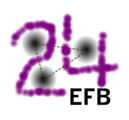Speaker
Description
Nuclear cluster structure often appears in the spectrum of light nuclei. The role of the nuclear clustering in the electric-dipole (E1) transitions is of great interest since they are closely related to important astrophysical reactions. Recently, an interesting speculation on the E1 excitation mechanism was made in the measurement of the photoabsorption cross section of 6Li that implied the coexistence of typical and cluster E1 excitation modes [1]. To understand the excitation mechanism of 6Li, we perform a fully microscopic six-body calculation with the correlated Gaussian method [2,3], which the formation and distortion of the nuclear clusters are naturally taken into account.
We calculate the E1 transition strengths and their transition densities and discuss how 6Li is excited by the E1 field as a function of the excitation energy. We find the out-of-phase transitions due to valence nucleon around the alpha cluster dominate in the low-lying energy regions below the alpha breaking threshold indicating “soft” Goldhaber-Teller(GT [4]) dipole excitation, which is very unique in 6Li, whereas the typical GT mode appears in the higher-lying energy regions. We show the various cluster components in the six-body wave function and discuss the role of the nuclear clustering in the E1 excitations of 6Li [5].
[1] T. Yamagata et al., Phys. Rev. C 95, 044307 (2017).
[2] J. Mitroy et al., Rev. Mod. Phys. 85, 693 (2013).
[3] D. Mikami, W. Horiuchi, and Y. Suzuki, Phys. Rev. C 89, 064316 (2014).
[4] M. Goldhaber and E. Teller, Phys. Rev. 74, 1056 (1948).
[5] S. Satsuka and W. Horiuchi, in preparation.
